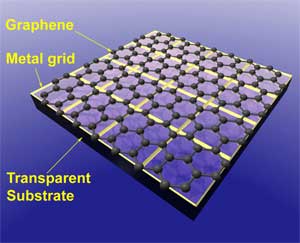Flexible monitors, screens that can be rolled up and deployed, and solar cells that are packed in a backpack as camping equipment - this is the vision that may be realized in the coming years with the help of the technology developed by the research group of Prof. Gil Markovich from the School of Chemistry

"The displays and screens that fill our lives today are made of several smart layers, and one of them is a transparent electrode - a transparent layer that conducts electricity, made of a hard and brittle, glass-like material," explains Prof. Markovitch, a physical chemist who studies electrical, magnetic and optical properties of nanomaterials . "Today the global trend is to develop electronic devices from flexible materials such as polymers (plastic). These devices will need flexible transparent conductors, which are convenient and cheap to manufacture. For this reason, many studies in this field are being conducted in the world, which have even produced a number of advanced technologies. Our development precisely meets the needs, and has important advantages over competing methods for producing flexible transparent conductors. I anticipate that it will have many applications as future technology develops.”
'Nano Spaghetti'
The transparent conductor developed in Prof. Markovitch's laboratory is a web of thin gold and silver nanowires - a kind of 'nano-spaghetti', produced by a 'wet' chemical method: dip the desired substrate in a solution containing nanometric particles of gold and/or silver, and the particles line up themselves in the form of threads on the surface of the entire surface - in a process known as self-organization, and a characteristic of the behavior of certain materials in the smallest dimensions. The innovative method is very convenient to use - by dipping, applying or spraying, and this is its great advantage. "In other technologies, based for example on the innovative material graphene or on carbon nanotubes, the components of the flexible transparent conductor must be manufactured separately, and then transferred to the surface on which the electronic device will be built," says Prof. Markovich. "This is a complex and expensive process, which has encountered many technological obstacles. In our method, the entire process is carried out in one step, and the conductor arranges itself on the substrate." As a result, the technology is also very effective for large surfaces, such as giant screens or powerful solar panels. And no less important: since it is about nanometer dimensions, the amounts of gold and silver are minimal, and the whole process is relatively cheap compared to the methods accepted today for the production of transparent conductors.
In addition to the essential flexibility properties, Prof. Markovich also deals with the optical properties of thin layers composed of metallic nanostructures. "Light is electromagnetic radiation, with waves in nanometer dimensions, therefore metallic nanostructures can be used as nanoantennas that receive and concentrate light waves," explains Prof. Markovitch. According to him, layers like the 'nano-spaghetti' developed in his lab can be used as antennas that will focus the sun's radiation hitting a wide area. In this way, it will be possible to significantly optimize the activity of solar cells, and produce a greater amount of electricity from the sun's energy.
promising applications
A first attempt to commercialize the innovative technology is being carried out today in collaboration with the company P.V. Nanosel from Migdal Hamek. In the first phase, it concerns the application of the technology for the production of sheets of solar cells made of polymers, which will allow camping enthusiasts to generate electricity in the field. In the future, it is possible that similar sheets will be mass-produced for coating various surfaces, walls, etc., and the necessary layers - among them the transparent conductor, the result of Prof. Markovitch's research - will be attached to the sheets using advanced printing methods. Possible applications of these layers in the future include: large LCD displays, foldable LED displays and defrosting or drying steam that accumulates on windows.
Prof. Gil Markovich is a physical chemist who heads a research group in the field of nanomaterials, as well as the head of the multi-faculty program for advanced degrees in materials and nanotechnologies. His research group deals with the preparation of nanostructures from different materials using chemical methods and the study of their unique physical properties, such as magnetic, electrical and optical properties. In recent years, the research group has been among the pioneers in a new field called nanochirality. In the coming year, Prof. Markovich will take over the headship of the School of Chemistry at Tel Aviv University. Apart from this, he is involved in various scientific education activities, including the 'Future Scientists' program in the unit for science-seeking youth at the university.

One response
Amazing !! The possibilities are unlimited, especially for a country with low energy and lots of sunshine like Israel!!!
Well done .